The Tragic Sinking of S.S. “Caribou”
A Second World War U-boat Attack on Newfoundland and Canada“I think we’re going to get hit tonight,” Captain Benjamin Taverner told Steward William Pearcey. At 3:50 a.m. on October 14, 1942, Taverner’s ferry S.S. Caribou became the last victim of German U-boats in the Battle of the St. Lawrence. With 137 victims, this sinking also resulted in the largest loss of life in Canadian and Newfoundland waters during World War II.
Each of the 238 people on board had their own reason for crossing the Cabot Strait. For the 74 civilians, the ferry was their only connection between Sydney, Nova Scotia and the Dominion of Newfoundland. It was another crossing for Caribou‘s 46 crew members. They were proud that the Newfoundland Railway’s Marine Division provided uninterrupted ferry service, despite the war. In addition, unlike in peacetime, the ferry carried 118 military personnel, many of whom were headed to Canadian and American bases. Others were Newfoundlanders on leave, some returning with wives and children.
When the German submarine U-69 sank S.S. Caribou, it set off a storm of shock and anger. People asked if the ferry was a legitimate target. There was outrage over the killing of women and children. Surviving crew questioned the protection provided by the Canadian Navy escort vessel H.M.C.S. Grandmere. Surviving servicemen questioned the emergency readiness of S.S. Caribou.
The tragedy affected communities across North America, but Port aux Basques and Channel lost the most people. This exhibit tells the story of the attack, the aftermath, and how we remember the 137 victims and 101 survivors.
Start reading the story


